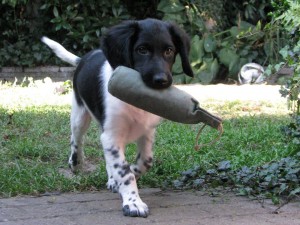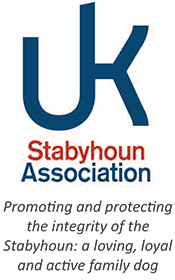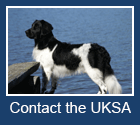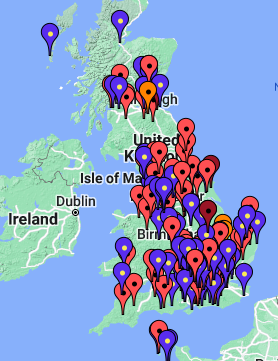By Helen Withey, author of ‘A Dog Knows Best – the owner’s guide to healthy feeding’

Helen Withey’s working Stabyhoun pup in training
I am often asked What is the best food to feed my dog? There is usually a simple answer: whatever you are happy with. But here are some things you might want to know…
Probably the easiest way is to feed a dog is with a complete dry food, but which one? In my experience, the most expensive brands spend a lot of money on advertising, free gifts and a substantial mark-up for retailers to encourage them to sell more. Consequently, there is not much left for good quality ingredients and so the food itself is compromised. Cheap, working dog food is exactly that. If you are paying around £20 for a bag of food, subtract the packaging costs, advertising, the retailer’s profit margin, manufacturing costs, profits of the wholesalers and finally the transportation costs. At £20, very little remains to purchase good quality ingredients.
When feeding dry food, be aware of the amount of cereal contained – none of which your dog needs. Expect to pay around £50 for a 15kg bag of a decent quality dry food. Better still if you have never heard of the brand since you are then probably paying more for high quality ingredients and less for advertising.
If you do decide to feed a complete dry food make sure it is soaked before giving it to your dog so that it swells in the bowl and not in your dog’s stomach. Feeding it to them completely dry could otherwise cause their system to rob water from other areas of the body, and even cause excessive drinking.
Tinned dog food is very often made from inferior cuts of meat of low nutritional value, disguised in a rich gravy which might look and smell good to you. With this option you are paying quite a lot for water since the average tin of wet dog food contains more H20 than any other ingredient. Some retailers have begun importing tinned dog food from places as far away as Canada, so you might want to consider the cost of that journey as well as the carbon footprint.
Commercial dog food contains no natural enzymes and during the manufacturing process a vast amount of the vitamin content is destroyed. To make up for this, artificial vitamins are sprayed on instead.
Raw feeding, in my experience, is by far the best diet for your dog – the way nature intended. Even our own doctors tell us to eat plenty of raw food and the same applies to your dog. There is now a growing trend towards raw feeding with numerous UK companies producing a good selection of frozen raw meats. Books are also available with advice on how to feed a raw and balanced diet. This way you know exactly what your dog is getting; quality ingredients and variety. It is often cheaper to feed your dog a raw diet because they eat less since the ingredients are easily digestible with concentrated goodness thus causing less waste at the rear. So all in all, a raw diet is a win-win situation. Give it a try!








